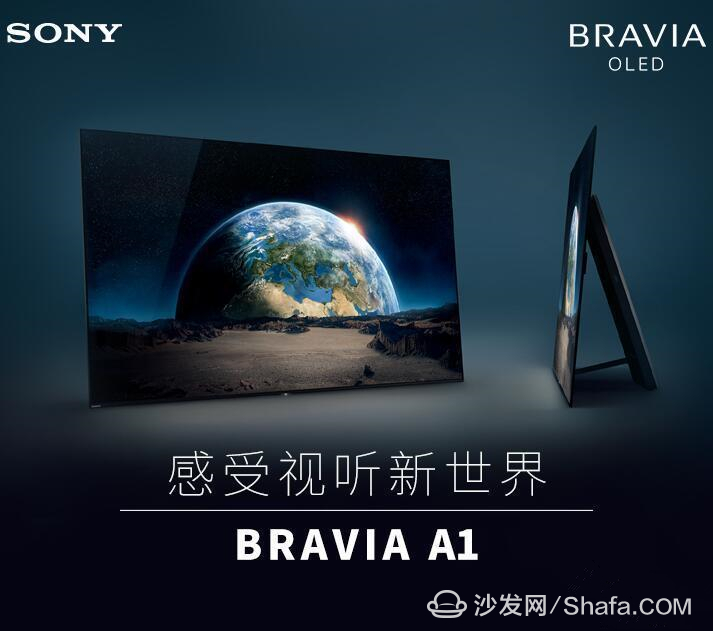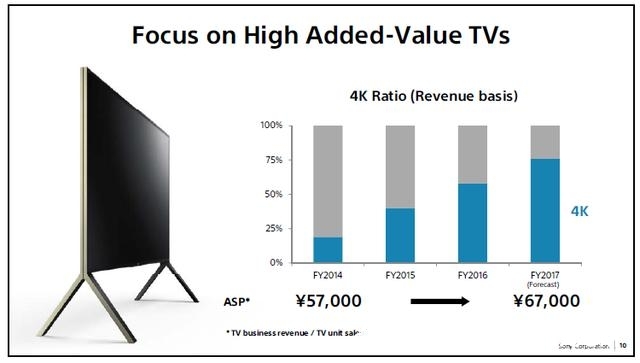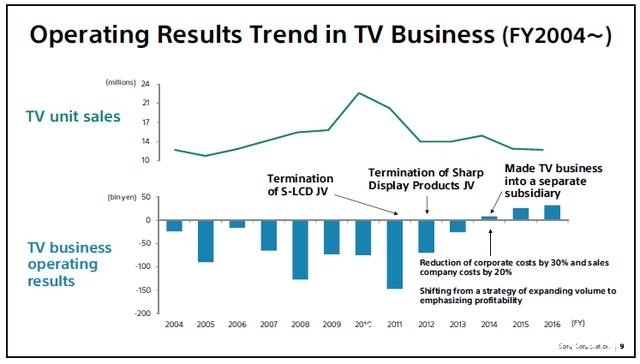In 2016, Sony’s television product structure continued to adjust, and the proportion of large screens and high-end models continued to rise. Sony’s home entertainment and audio services (including TV and audio and video services) were upgraded for two consecutive quarters through continued improvement in operating efficiency and costs. Fiscal year operating profit expectations and strong growth in FY17.

Relying on the advantages of HDR's full-industry chain, Sony has captured the TV industry's new HDR technology milestone to make a beautiful article. In FY 2016, with the accumulation of advanced technologies and rich imaging technologies, Sony’s flagship 4K HDR TV Z9D received enthusiastic market feedback and Brightly focused on sales performance.
In 2017, Sony TV’s goal is to further revive the once-weak business, and formally returning to the OLED camp may be a key step. Why did you choose this time? The executive vice president of Sony Corporation, Ichiro Takagi, said that because of the quality of the procurement panel has reached a "satisfactory level."

The new OLED A1 debuted at the Consumer Electronics Show in Las Vegas in January. In the absence of traditional speakers, A1 relies on ultra-thin screen vibrations for sound. Mr. Kazuo Hirai, president and CEO of the design company, once stated that A1 represents the only level of technology that Sony can provide.
The launch of new products has been 7 years since the last OLED TV exited the market. After experiencing “seven-year itchâ€, Sony has given considerable hope to the OLED product line. With the introduction of A1, Sony is trying to increase its global TV market share in 2017 from 8% to 10%. It is also planned that by 2022, OLED TV sales will reach 10% of TV sales.

Experienced A1's 55-inch products, the impression is more profound there are these points:
The first is the narrow border design of the product.
Not only the narrow frame, but also this series of products does not have a base, can not find the speaker openings on the four sides, it touches Sony's "Slim of Living" design concept that began in 2015.
Personally think that the benefits of this design are three, one is to reduce the appearance of the body as much as possible to interfere with the picture; the second is through a simple appearance, can better integrate with the home environment; third is a sense of integration of the whole machine Strong.
Followed by the "voice and picture together" technology.
On the common TVs in the market, the speakers are usually on the bottom or on both sides of the screen. When they are watched, they usually appear as sound and the picture is not uniform. For example, if a singer's face is in the middle of the screen, if the sound and picture are unified, the TV needs to sound in the middle, but the speaker's position is fixed.
The Sony A1 uses an exclusive Acoustic Surface technology to act on the A1's OLED panel through a dedicated drive device, allowing the panel to vibrate and emit sound waves, making it the world's first large-screen TV that can directly use the screen to make sounds. The hand touches the panel to feel obvious vibrations, and from the audiovisual experience, I do feel the "unity of sound and picture". For example, the bird's cry will follow the image "move."
The screen sound field technology enables the A1's OLED panel to simultaneously display and play the role of the speaker diaphragm. Therefore, the entire machine does not need to use an additional speaker to generate sounds, thereby enhancing the sense of space and three-dimensionality.
The last is a pixel-level quality experience.
What impresses me most is the product's good light transmission performance, high contrast, deep black color, and pure white color. The viewing angle is also good from different directions, with no noticeable whitening or color decay.
In addition to using OLED panels, this should benefit from the use of the Sony X1 Advanced Image Processing IC and HDR Dynamic Image Reshaping Technology.
Unlike ordinary TVs, which are only adjusted along a black-and-white contrast curve, the X1 Advanced Processing chip analyzes the color and brightness of each object on the screen. Each object on the screen is re-created individually to achieve a greater depth of the picture. , more detailed texture, in order to obtain a more realistic picture. Even non-HDR film sources can exhibit HDR features.
It is also known that the Sony Semiconductor team located in Atsugi City, in the southwest of Tokyo, and the Sony TV Department in the capital have jointly participated in the development of the X1 Advanced Edition. Television designers responsible for algorithmic and standard analysis often flew to Sony's film production subsidiary in California, where they exchanged ideas with the creators on how to reproduce lifelike images.
Providing commercial OLED TVs to TV stations also helped Sony raise the level of image production. A1 also received the support of Hollywood experts. A Sony employee recalled that many experts were impressed with A1 and thought that the realization of such high-definition television for home use would even change the way movies were made.
In 2007, Sony introduced the world's first home-use OLED TV. The then-president of the company, Liang Zhongzhi, described it as "the flag-bearer who can rejuvenate the television business." However, large-screen OLED panels were not yet mass-produced at the time, and 11-inch screens were difficult to exhibit the advantages of OLEDs. Today, large-screen, high-quality OLED panels are already available, and Sony is also focused on using process chips, the “X1 Advanced Edition†to create product differentiation. At the moment when high-end, large-screen products are becoming a trend, OLEDs with A1 as the "new starting point" will be a sharp edge for revitalizing the TV business.
Smart TV/box information can focus on smart TV information network sofa butler (http://), China's influential TV box and smart TV website, providing information, communication, etc. on TV boxes, smart TVs, smart TV software, etc. Answering questions.

Relying on the advantages of HDR's full-industry chain, Sony has captured the TV industry's new HDR technology milestone to make a beautiful article. In FY 2016, with the accumulation of advanced technologies and rich imaging technologies, Sony’s flagship 4K HDR TV Z9D received enthusiastic market feedback and Brightly focused on sales performance.
In 2017, Sony TV’s goal is to further revive the once-weak business, and formally returning to the OLED camp may be a key step. Why did you choose this time? The executive vice president of Sony Corporation, Ichiro Takagi, said that because of the quality of the procurement panel has reached a "satisfactory level."

The new OLED A1 debuted at the Consumer Electronics Show in Las Vegas in January. In the absence of traditional speakers, A1 relies on ultra-thin screen vibrations for sound. Mr. Kazuo Hirai, president and CEO of the design company, once stated that A1 represents the only level of technology that Sony can provide.
The launch of new products has been 7 years since the last OLED TV exited the market. After experiencing “seven-year itchâ€, Sony has given considerable hope to the OLED product line. With the introduction of A1, Sony is trying to increase its global TV market share in 2017 from 8% to 10%. It is also planned that by 2022, OLED TV sales will reach 10% of TV sales.

Experienced A1's 55-inch products, the impression is more profound there are these points:
The first is the narrow border design of the product.
Not only the narrow frame, but also this series of products does not have a base, can not find the speaker openings on the four sides, it touches Sony's "Slim of Living" design concept that began in 2015.
Personally think that the benefits of this design are three, one is to reduce the appearance of the body as much as possible to interfere with the picture; the second is through a simple appearance, can better integrate with the home environment; third is a sense of integration of the whole machine Strong.
Followed by the "voice and picture together" technology.
On the common TVs in the market, the speakers are usually on the bottom or on both sides of the screen. When they are watched, they usually appear as sound and the picture is not uniform. For example, if a singer's face is in the middle of the screen, if the sound and picture are unified, the TV needs to sound in the middle, but the speaker's position is fixed.
The Sony A1 uses an exclusive Acoustic Surface technology to act on the A1's OLED panel through a dedicated drive device, allowing the panel to vibrate and emit sound waves, making it the world's first large-screen TV that can directly use the screen to make sounds. The hand touches the panel to feel obvious vibrations, and from the audiovisual experience, I do feel the "unity of sound and picture". For example, the bird's cry will follow the image "move."
The screen sound field technology enables the A1's OLED panel to simultaneously display and play the role of the speaker diaphragm. Therefore, the entire machine does not need to use an additional speaker to generate sounds, thereby enhancing the sense of space and three-dimensionality.
The last is a pixel-level quality experience.
What impresses me most is the product's good light transmission performance, high contrast, deep black color, and pure white color. The viewing angle is also good from different directions, with no noticeable whitening or color decay.
In addition to using OLED panels, this should benefit from the use of the Sony X1 Advanced Image Processing IC and HDR Dynamic Image Reshaping Technology.
Unlike ordinary TVs, which are only adjusted along a black-and-white contrast curve, the X1 Advanced Processing chip analyzes the color and brightness of each object on the screen. Each object on the screen is re-created individually to achieve a greater depth of the picture. , more detailed texture, in order to obtain a more realistic picture. Even non-HDR film sources can exhibit HDR features.
It is also known that the Sony Semiconductor team located in Atsugi City, in the southwest of Tokyo, and the Sony TV Department in the capital have jointly participated in the development of the X1 Advanced Edition. Television designers responsible for algorithmic and standard analysis often flew to Sony's film production subsidiary in California, where they exchanged ideas with the creators on how to reproduce lifelike images.
Providing commercial OLED TVs to TV stations also helped Sony raise the level of image production. A1 also received the support of Hollywood experts. A Sony employee recalled that many experts were impressed with A1 and thought that the realization of such high-definition television for home use would even change the way movies were made.
In 2007, Sony introduced the world's first home-use OLED TV. The then-president of the company, Liang Zhongzhi, described it as "the flag-bearer who can rejuvenate the television business." However, large-screen OLED panels were not yet mass-produced at the time, and 11-inch screens were difficult to exhibit the advantages of OLEDs. Today, large-screen, high-quality OLED panels are already available, and Sony is also focused on using process chips, the “X1 Advanced Edition†to create product differentiation. At the moment when high-end, large-screen products are becoming a trend, OLEDs with A1 as the "new starting point" will be a sharp edge for revitalizing the TV business.
Smart TV/box information can focus on smart TV information network sofa butler (http://), China's influential TV box and smart TV website, providing information, communication, etc. on TV boxes, smart TVs, smart TV software, etc. Answering questions.
Energy Storage System,Solar Energy Storage System,2Mw Energy Storage System,Lifepo4 Energy Storage System
Jiangsu Stark New Energy Co.,Ltd , https://www.stark-newenergy.com